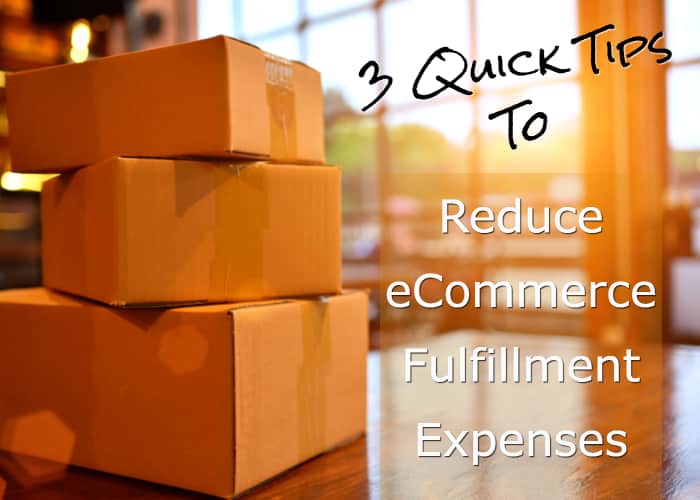3 Quick Tips to Reduce eCommerce Fulfillment Expenses
As eCommerce fulfillment becomes a key component of delivering your brand promise, it seems inevitable that expenses will rise.
Getting orders to customers more quickly while maintaining a high level of quality in packaging and product safety inevitably takes some thought, so it follows that eCommerce fulfillment expenses should be carefully monitored as new initiatives are rolled out.
However, focusing more attention on a few simple parts of this process can be surprisingly effective.

3 Tips to Bring Down Your eCommerce Fulfillment Expenses
There are many ways to manage eCommerce fulfillment expenses, but these suggestions offered by Capacity CEO Jeff Kaiden at our partner event earlier this year are the ones we feel offer the most bang for your buck.
Jeff was clear that these suggestions account for roughly 80% of the opportunity to reduce eCommerce fulfillment expenses and position your brand for greater scalability.
1) Eliminate Paper Packing Slips
Our number one tip is easy: get rid of your paper packing slip. Ask yourself, is that basic piece of paper really crucial to your brand's unboxing experience?
Many brands only include one because it's what they've always done, but in our experience no-one's reading it. In an increasingly paperless world, the packing slip isn't conveying any important message or information beyond what you've already emailed to your customer or included in their app.
Getting rid of this item also takes a step out of the packing process for our team members, as well as saving a little on printing and materials. This one simple step, applied across tens of thousands of orders, can quickly add up to reduce your eCommerce fulfillment expenses.
If there's a compelling case to keep that paper slip for branding purposes, we can discuss ways to reduce that cost or incorporate its value into another area of your packaging.
In most cases, however, it's worth simply consigning this piece of paper to the file marked "Things we did for the sake of it."
2) Avoid Boxes with Awkward Assembly
Another relatively quick fix to keep eCommerce fulfillment expenses down comes in the form of the humble box. It's an important part of the packaging equation, but did you know that the wrong choice of box can quickly increase your eCommerce fulfillment expenses?
Here's why...
The key to a good box, at least from your fulfillment partner's persepctive, is how easy (or not) it is to assemble. If assembly takes more time, well, you know the old adage about what time equals.
The type of boxes that require our team to tape the bottom, hold down the sides, then tape the top, all take the employee's time away from some other aspect of your fulfillment. They take longer to get the job done and your eCommerce fulfillment expenses go up as a result.
The best box is the one that our machines can form, which automates the process and maximizes our resources. That's followed by the type of box that a team member can form by simply pushing the sides down, adding a top, and taping a single piece or wafer seal to complete construction.
As well as construction time, easy-to-assemble boxes affect how quickly we can get orders out the door after the team picks and packs the required products.
Any aspect of the process that adds time and complexity to what should be a simple assembly is worth looking at. If it can be simplfied, there's a very good chance we can make your eCommerce fulfillment less expensive and help to scale your business to larger order volumes in a shorter period of time.

3. Even Out Holiday Surges
It's no secret that peak season fulfillment is a rollercoaster ride for retailers and their fulfillment partners. Around Black Friday and into the week of Cyber Monday, the Capacity team is at full strength and working around the clock to get orders out as efficiently as the other 51 weeks of the year.
Inevitably, that comes at a cost. This is the period during which we pay the most in terms of additional labor and employee hours. The flip side is that any clients who can help level out that demand across other periods of the year, even by just a few weeks, give us a way to reduce their eCommerce fulfillment expenses.
Obviously the holiday season - and the build up to it - will always be our busiest time of yeat. That isn't changing any time soon, but if we can work together on solutions that spread demand and brand promotions out more evenly throughout the year, that major holiday spike translates to a smaller percentage of your annual total.
As a result, it also allows eCommerce fulfillment partners like Capacity to reduce costs. We're able to utilize the excess resources we have at quieter times of the year - space, equipment, employees, etc - when they're not working at their maximum, which spreads their cost out over a greater number of days and brings the expense down for your business.
The bottom line of this final suggestion comes down to communication. Share your forecasts, tell your fulfillment partner what's going on, and work together to find creative solutions that maximize our resources and allow you to reduce some of the cost burden from eCommerce fulfillment expenses.
We frequently see clients make exceptional progress and bring costs down significantly when they're able to improve the communication process. We start to know about things many months ahead of time and can effectively plan for them, minimizing cost and increasing efficiency.
Attempting to reduce eCommerce fulfillment expenses can seem like a mountain to climb, so why not start out with a gentle hike before tackling the upper slopes?
The quick tips outlined above make a great place to start, so don't hesitate to contact us if you're ready to take these first steps on the road to reduced costs and increased scalability.